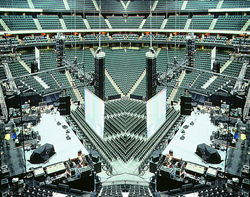About 15 or so years ago, I went to a rock concert at a stadium in Chicago. Having heard this band’s best-recorded music on some excellent small systems, including high-end four-channel setups, I looked forward to this concert with great anticipation.
They were known for having elaborate and advanced concert setups. I expected many stacks of loudspeakers and amazing “big, immersive” sound along with a huge video display.
Unfortunately, the outcome proved just the opposite – talk about disappointing! It was barely loud enough, muddy, and distant-sounding.
I couldn’t even tell whether the giant loudspeaker stacks on each side of the stage were supposed to create stereo sound.
They were just too far away, and their coverage of the audience was inadequate.
The show may have been better for those who were close to the stage, but the rest of us could get superior sound with our home stereos.
Sound reinforcement (in general terms) has improved a lot since then, and good sound for every audience member is now possible in most venues. Although concerts are commonly recorded and produced in 5.1 format for DVD, surround sound for live concert reinforcement is still almost nonexistent.
Because progress is inevitable, it seems likely some day concerts will be routinely presented in high-quality surround sound.
But even if the budget is large enough, the laws of physics still create problems for design of a large surround sound system. Fortunately, we can make useful compromises, and as loudspeaker designs improve, we can more readily achieve effective stereo sound for an audience.
This is a good basis for surround sound, which can utilize many of the same principles.
Start With Stereo
Achieving good stereo sound for a large audience requires careful design with close attention to acoustic issues. The basic requirement is for each listener to hear each of the loudspeakers at nearly the same level, nearly the same time, and with matched frequency response.















